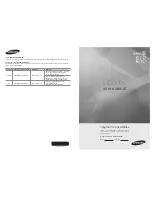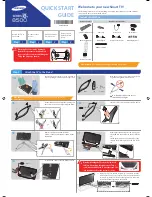
L
L
L
S-VIDEO
OUT
1
2
DRIV
G
+
R
–
+
–
L
EXTERNAL
SPEAKERS
AUDIO
SELECT OUT
R/
MONO
R/
MONO
R/
MONO
INPUT 1
INPUT 2
INPUT
SELECT
CAUTION
TO AVOID DAMAGE:
1. DO NOT CONNECT
SPEAKER OUTPUT
TO A SEPARATE
AMPLIFIER OR
TO SPEAKERS
CONNECTED TO
ANOTHER
PRODUCT.
2. DO NOT CONNECT
LEFT AND RIGHT
SPEAKER OUTPUTS
TOGETHER.
HI-FI OUT
CABLE/ANTENNA
VIDEO
EXT
INT/EXT
SURR
SPEAKER
ANT B
CONVERTER
ANT A
29
Monitor Panel
EXTERNAL SPEAKERS Terminals
–
permit direct
connection of auxiliary speakers. Connection details are
on page 43.
CABLE/ANTENNA Connectors–used when attaching
either a home antenna or a cable-TV system to your TV.
Connection details are on pages 30-32.
SPEAKER Switch
–
when you connect additional speakers
to the EXTERNAL SPEAKERS terminals on the TV, this
switch lets you optimize the sound for the speaker location
you choose.
• If you place the speakers on each side of the TV, put
switch in EXT position. If the left side of the switch is
labeled EXT, the internal audio from the TV’s speakers
will be muted.
• If you place the speakers behind the viewer (at the back
of the room), put switch in INT/EXT SURR position.
This maintains normal volume level of the TV’s
internal speakers and a surround signal to rear
speakers.
• Details about connecting speakers to the TV are on
page 43.
IMPORTANT: Always place switch in INT/EXT SURR
position if no external speakers are used (or if external
speakers are ever disconnected).
SELECT OUT Jacks–provide fixed-level audio and
video output from whatever is displayed on the TV
screen (see notes below). Provide audio and video
signals suitable for recording.
Can be used for several applications such as:
• VCR editing with two or three VCRs (page 35).
• recording TV programs onto a camcorder (page 39).
• recording cable-TV programs onto a VCR that is not
cable-ready (page 35).
• recording audio onto an audio cassette tape recorder
(page 41).
Notes
• Remember that whatever you want to record must be
displayed on the TV screen during recording.
• Video signals from the S-VIDEO connector can not be
recorded from the SELECT OUT VIDEO jack. To record
from an S-VHS component connected to the S-VIDEO
connector, you must also connect the video cable to the
VIDEO INPUT 1 jack and then select channel 91 on the TV
screen.
• On-screen displays such as menus and status displays can not
be recorded from this jack.
• Special features such as picture-in-picture can not be recorded
from this jack.
INPUT 2 Jacks–provide for direct connection of video
devices (like VCRs) or compatible home computers and
TV games with video/audio outputs.
To see the signals from a device that is connected to the
INPUT 2 jacks, tune your TV to channel 92.
INPUT 1 Jacks–provide for direct connection of video
devices (like VCRs) or compatible home computers and
TV games with video/audio outputs.
To see the signals from a device that is connected to the
INPUT 1 jacks, tune your TV to channel 91.
S-VIDEO Connector–provides for direct S-VHS video
connection from S-VHS VCR or camcorder.
Remember to also connect the S-VHS VCRs or
camcorder’s audio jack(s) to the TV’s INPUT 1 LEFT
and/or R/MONO audio jacks. This is necessary because
S-Video cables only carry the super video (picture), not
the audio signal. Connection details are on pages 36
and 39.
Signals from S-VHS devices connected to the TV’s
S-VIDEO connector and INPUT 1 audio jack(s) can be
viewed by pressing the TV button followed by 9 then 0
on the remote control–(or by scanning to TV channel 90
if you have added “90” to channel memory as described
on page 26).
Note: If you want to use the SELECT OUT jacks, remember to
also connect the S-VHS component’s regular video cable to the
VIDEO INPUT 1 jack, and then tune to channel 91.
HI FI OUT Jacks–feed volume-controlled stereo audio
out from whatever is displayed on the TV screen. Allow
connection of audio amplifier and lets you adjust sound
level with TV’s remote.
3
4B
5B
4A
6A
5A
6B
7
8
7
6A
5A
4A
8
6B
5B
4B
3
2
1
1
2
Содержание P60100
Страница 3: ...C O L O R T V USER S GUIDE...
















































